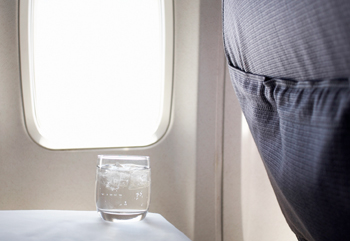 |
|
Please note: This summary is provided to help you understand the regulations. Consult the references provided for links to the full text of the regulations.
 Aircraft Drinking Water Aircraft are supplied with drinking water through temporary connections at the airports they pass through. Ensuring the quality of water from multiple sources poses unique challenges, so special rules have been developed for monitoring onboard drinking water systems that differ in some respects from rules applying to stationary facilities. Air carriers typically board aircraft drinking water using designated watering points (facilities where water is transferred from a water supply to an aircraft, including water cabinets, carts, trucks, and hoses). Once water is onboard an aircraft, the U.S Environmental Protection Agency regulates the distribution of water for consumption under the Aircraft Drinking Water Rule (ADWR). With this rule, air carriers are subject to sampling, maintenance, reporting and recordkeeping requirements, and may be subject to audits or inspections to ensure that safe and reliable drinking water is provided to aircraft passengers and crew. This TERC topic page covers EPA's Aircraft Drinking Water Rule. The Food and Drug Administration (FDA) is responsible for regulating watering points (21 CFR 1250). Who is covered by the regulations? The ADWR affects aircraft which convey passengers in interstate commerce that board water. Aircraft that do not provide water for human consumption or those with water systems that do not regularly serve an average of at least twenty-five individuals daily are not regulated under this rule. The ADWR applies to the aircraft’s onboard water system, the components of which include: water service panel, storage tanks, pipes, valves, treatment devices, and plumbing fixtures within the aircraft that supply water to passengers or crew. The final ADWR only addresses aircraft within U.S. jurisdiction; however, EPA supported an effort led by the World Health Organization to develop international guidelines for aircraft drinking water. What is the purpose of the regulations? In 2004, an EPA study found all aircraft potable water systems (PWSs) to be out of compliance with the National Primary Drinking Water Regulations (NPDWR), primarily because airlines were not monitoring water quality. The airline industry responded to EPA that it was not feasible to meet the existing NPDWRs, which were designed for traditional, stationary public water systems, not mobile aircraft water systems. For example, the industry argued that aircraft fly to multiple destinations throughout the course of any given day and may board drinking water from sources at any of these destinations and that checking the quality of the water at each location would be too burdensome and would prevent aircraft from maintaining rigorous operating schedules. The Aircraft Drinking Water Rule finalized in 2009, amended the NPDWRs to fit the unique characteristics of aircraft public water systems while protecting the public from illnesses caused by microbiological contamination. Regulations Aircraft public water systems are subject to the requirements of the National Primary Drinking Water Regulations (NPDWRs) under the Safe Drinking Water Act. The Aircraft Drinking Water Rule amends NPDWRs for these systems, building on existing aircraft operations and maintenance programs. The final ADWR was issued on Oct. 19, 2009 by EPA and is codified at 40 CFR 141.800. To ensure that safe and reliable drinking water is provided to aircraft passengers and crew, the rule provides multiple-barrier protection through requirements for coliform sampling, best management practices, corrective action, public notification, monitoring and operator training. The frequency of coliform monitoring is tied to the frequency of disinfection and flushing of the aircraft water system. For example, if disinfection and flushing is performed quarterly, then at least one sample set must be taken annually, whereas, if disinfection and flushing is performed only semi-annually, then sampling must be performed quarterly. Two coliform samples are taken per monitoring period. One sample must be taken from a lavatory and one sample from a galley. Any total coliform-positive sample must be further analyzed for the presence of E. coli. If any routine sample is total coliform positive and E. coli-negative, the carriers must:
If the air carrier chooses to restrict public access to the water system, the air carrier must initiate public notification at that time (i.e., no later than 72 hours after being notified by lab of total coliform positive result) and continue until the aircraft water system is returned to unrestricted public access. If any routine sample is E. coli-positive, the carriers must:
The air carrier must conduct disinfection and flushing of the aircraft water system in accordance with, or consistent with, the water system manufacturer’s recommendations. This allows for equipment-specific designs and for flexible implementation with the evolution of technology. In cases where a recommended routine disinfection and flushing frequency is not specified by the aircraft water system manufacturer, the air carrier is given the flexibility to choose a disinfection and flushing frequency, and corresponding monitoring frequency, specified in the rule. More Resources Guidance Manual for the Aircraft Drinking Water Rule (ADWR). This guidance manual will assist air carriers that are subject to the ADWR with implementation of the rule’s provisions. |